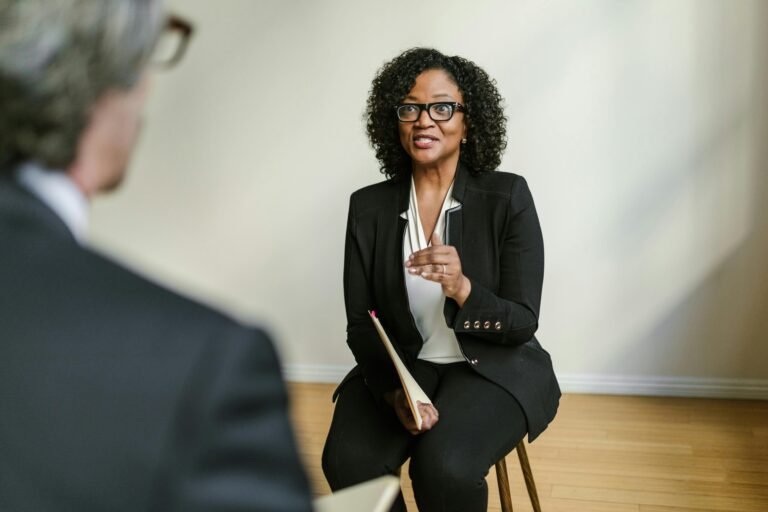The STAR method (Situation, Task, Action, Result) is an excellent approach to answering behavioral interview questions. It helps you present your experience in a structured manner, allowing you to demonstrate your skills and suitability for the position you are applying for. If you’re interviewing for a college adjunct professor role, the STAR method can help you effectively highlight your teaching experience, student engagement strategies, and academic contributions.
Below are 10 original examples of how you can use the STAR method to answer common questions in a college adjunct professor job interview. These examples focus on different aspects of teaching, including course management, student engagement, handling challenges, and collaborating with colleagues. By tailoring these examples to your own experiences, you can present yourself as a strong candidate for the role.
Interview Questions with Sample STAR Responses
Tell me about a time when you had to manage a difficult student in your class.
Sample Response:
Situation: In my previous role as an adjunct professor at XYZ University, I had a student who consistently disrupted class by engaging in side conversations and distracting other students during lectures.
Task: My responsibility was to address the student’s behavior while maintaining a positive and respectful learning environment for the rest of the class.
Action: I first approached the student after class to discuss the issue privately. I explained how their behavior was affecting the class and asked if there were underlying reasons for their actions. We developed a plan to help them stay engaged in class, including specific participation goals and opportunities for one-on-one meetings.
Result: The student became more engaged in class discussions and showed significant improvement in their behavior. The overall classroom atmosphere became more focused and productive, and the student ultimately succeeded in the course. This experience highlighted my ability to address behavioral issues while fostering a supportive learning environment.
Tell me about a time when you had to adapt your teaching style to meet the needs of different students.
Sample Response:
Situation: In a recent course I taught on Introduction to Psychology, I had a diverse group of students with varying learning styles, including visual, auditory, and kinesthetic learners.
Task: My task was to ensure that all students were able to engage with and retain the course material effectively.
Action: I adapted my teaching methods by incorporating a variety of materials: visual aids like diagrams and videos for visual learners, lectures and group discussions for auditory learners, and hands-on activities and case studies for kinesthetic learners. I also provided additional resources like online quizzes and study guides to support different study habits.
Result: Students were more actively engaged in the course, and their performance improved across various assignments. The course evaluations reflected a positive response to the variety of teaching methods used, and several students mentioned how the different approaches helped them understand the material better. This experience emphasized my ability to adapt my teaching style to meet diverse learning needs.
Tell me about a time when you had to create or revise a course syllabus.
Sample Response:
Situation: As an adjunct professor at ABC College, I was asked to revise the syllabus for an introductory course on American Literature, as the existing syllabus was outdated and did not incorporate recent academic trends or student feedback.
Task: My task was to revise the syllabus to make it more engaging, relevant, and aligned with current pedagogical standards.
Action: I reviewed the latest research and trends in American Literature, solicited feedback from previous students, and consulted with my department colleagues. I integrated more diverse readings and included assignments that encouraged critical thinking and engagement with contemporary issues. I also made sure to include clear grading rubrics and set realistic deadlines for students.
Result: The revised syllabus was well-received by both students and colleagues. Students reported feeling more engaged with the course content, and the course saw higher student satisfaction and better academic performance. This experience demonstrated my ability to innovate and revise course materials to meet current educational needs.
Tell me about a time when you had to collaborate with colleagues to improve a course or department.
Sample Response:
Situation: While teaching at DEF University, I was part of a team of adjunct professors who taught courses in the same department, and we noticed that students were struggling with a particular subject area, research methodology.
Task: My role was to collaborate with my colleagues to create a strategy to better support students in mastering this challenging subject.
Action: We held regular department meetings to discuss students’ struggles, shared best practices for teaching the subject, and designed a new curriculum with additional resources and practice assignments. We also introduced collaborative study groups and peer mentoring for students who needed extra help.
Result: After implementing the changes, students showed noticeable improvement in their understanding of research methodology. Course feedback improved, and the department received positive comments about the increased support. This experience highlighted my ability to collaborate with colleagues to enhance academic outcomes for students.
Tell me about a time when you had to handle a challenging teaching situation in an online course.
Sample Response:
Situation: During the COVID-19 pandemic, I transitioned my history course to an online format for the first time at GHI College. Several students were struggling to adapt to online learning and were falling behind.
Task: My task was to ensure that all students had equal access to the course material and were able to successfully complete the course.
Action: I implemented a series of asynchronous and synchronous activities to engage students in different ways. I recorded short video lectures for those who preferred self-paced learning, hosted live Q&A sessions for real-time support, and made myself available for individual student consultations. I also provided clear instructions for navigating the online platform and offered additional resources for those who were having difficulty.
Result: As a result, most of the students were able to catch up with the course material and improve their academic performance. The overall class satisfaction rate was high, and I received positive feedback regarding the variety of learning methods I provided. This experience demonstrated my adaptability and ability to manage online learning environments effectively.
Tell me about a time when you had to motivate students who were disengaged or struggling academically.
Sample Response:
Situation: As an adjunct professor at JKL College, I noticed a group of students in my Literature class were disengaged and struggled with completing assignments.
Task: My task was to re-engage these students and motivate them to succeed academically.
Action: I implemented a series of interactive assignments that allowed students to connect the course material to real-world experiences. I also held one-on-one meetings with the students to understand their challenges and provided personalized feedback and encouragement. Additionally, I incorporated peer reviews and group discussions to foster a sense of community and accountability.
Result: Many of the disengaged students began to show more interest in the material and produced higher-quality work. The overall class performance improved, and several students mentioned how they felt more motivated and supported in the course. This experience demonstrated my ability to motivate and support students who were struggling academically.
Tell me about a time when you integrated technology into your teaching to enhance learning.
Sample Response:
Situation: At MNO University, I taught a political science course where students struggled with understanding complex theories and concepts.
Task: My task was to use technology to help make these complex ideas more accessible and engaging for students.
Action: I introduced a variety of digital tools, including interactive polling, multimedia presentations, and discussion boards, to encourage student participation. I also used online simulation tools where students could apply political theories in real-world scenarios, which made the concepts more tangible.
Result: The use of technology significantly enhanced students’ understanding of the course material, and the students showed increased engagement in class. Many students expressed that the interactive tools helped them grasp difficult concepts more effectively. This experience showcased my ability to integrate technology to improve the learning experience.
Tell me about a time when you provided constructive feedback to a student that helped them improve.
Sample Response:
Situation: In my recent English composition course at PQR College, I had a student who consistently received lower grades on their essays due to unclear thesis statements and weak argumentation.
Task: My task was to provide constructive feedback to help the student improve their writing skills.
Action: I met with the student individually to discuss their assignments. I provided specific examples of where their arguments were weak and gave them a structured approach for developing clearer thesis statements. I also recommended writing workshops and peer review sessions to further improve their skills.
Result: The student’s performance significantly improved over the next few assignments. By the end of the semester, their essays demonstrated stronger arguments and clearer thesis statements. This experience demonstrated my ability to provide constructive feedback that leads to academic growth.
Tell me about a time when you had to balance teaching and research responsibilities.
Sample Response:
Situation: As a part-time adjunct professor at STU University, I had to balance my responsibilities between teaching an introductory course and working on my research project for an academic journal.
Task: My task was to effectively manage both teaching and research without compromising the quality of either.
Action: I carefully planned my schedule to ensure that I allocated time for both teaching preparation and research. I streamlined my research work by setting realistic goals for each week, and I utilized the same academic literature for both my research and course material to save time. I also leveraged teaching experience to inform my research and vice versa.
Result: I successfully completed my research project and submitted it for publication while delivering high-quality lectures and receiving positive evaluations from students. This experience demonstrated my ability to balance multiple responsibilities effectively.
Tell me about a time when you had to engage with a student who was not participating in class discussions.
Sample Response:
Situation: In one of my political science classes, I noticed a student was not actively participating in class discussions or group activities.
Task: My task was to encourage the student to become more engaged without making them feel singled out or uncomfortable.
Action: I reached out to the student privately after class to ask if they were experiencing any difficulties with the course material. The student shared that they felt intimidated by the larger class size. I worked with the student to create smaller discussion groups and made sure to ask them direct questions in a supportive and non-threatening manner.
Result: Over time, the student became more comfortable and began contributing to discussions, both in smaller groups and in the larger class. Their participation increased, and their academic performance improved. This experience highlighted my ability to support students who may be struggling with engagement and participation.
In Closing
Using the STAR method in your college adjunct professor interview allows you to effectively showcase your skills, problem-solving abilities, and teaching expertise. Whether discussing how you handle classroom challenges or how you use technology to enhance learning, the STAR method provides a structured approach to answering behavioral questions. Tailor these examples to your own experiences, and you’ll be well-prepared to impress any interview panel and land your next adjunct professor position.
Good luck with your interview preparation!
Related Posts
10 Common Interview Questions for Adjunct Professors with Sample Responses
College Adjunct Professor Resume Action Phrases
How to Use the STAR Method to Answer Interview Questions
How to Conduct a Self-Assessment to Identify Your Strengths and Weaknesses
Sample Resume: Adjunct Professor (With Real-World Experience)
Sample Resume: Adjunct Professor (No Teaching Experience)








